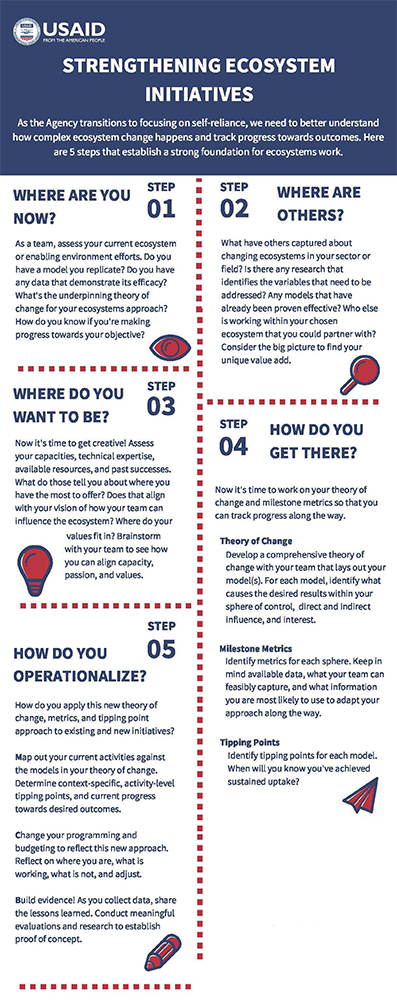- What We Do
- Agriculture and Food Security
- Democracy, Human Rights and Governance
- Economic Growth and Trade
- Education
- Environment and Global Climate Change
- Gender Equality and Women's Empowerment
- Global Health
- Humanitarian Assistance
- Transformation at USAID
- Water and Sanitation
- Working in Crises and Conflict
- U.S. Global Development Lab
Speeches Shim
STRENGTHENING ECOSYSTEM INITIATIVES
As the Agency transitions to focusing on self-reliance, we need to better understand how complex ecosystem change happens and track progress towards outcomes. Here are 5 steps that establish a strong foundation for ecosystems work.
1) WHERE ARE YOU NOW?
As a team, assess your current ecosystem or enabling environment efforts. Do you have a model you replicate? Do you have any data that demonstrate its efficacy? What's the underpinning theory of change for your ecosystems approach? How do you know if you're making progress towards your objective?
2) WHERE ARE OTHERS?
What have others captured about changing ecosystems in your sector or field? Is there any research that identifies the variables that need to be addressed? Any models that have already been proven effective? Who else is working within your chosen ecosystem that you could partner with? Consider the big picture to find your unique value add.
3) WHERE DO YOU WANT TO BE?
Now it's time to get creative! Assess your capacities, technical expertise, available resources, and past successes. What do those tell you about where you have the most to offer? Does that align with your vision of how your team can influence the ecosystem? Where do your values fit in? Brainstorm with your team to see how you can align capacity, passion, and values.
4) HOW DO YOU GET THERE?
Now it's time to work on your theory of change and milestone metrics so that you can track progress along the way.
Theory of Change
Develop a comprehensive theory of change with your team that lays out your model(s). For each model, identify what causes the desired results within your sphere of control, direct and indirect influence, and interest.
Milestone Metrics
Identify metrics for each sphere. Keep in mind available data, what your team can feasibly capture, and what information you are most likely to use to adapt your approach along the way. Identify tipping points for each model. When will you know you've achieved sustained uptake?
Tipping Points
Identify tipping points for each model. When will you know you've achieved sustained uptake?
5) HOW DO YOU OPERATIONALIZE?
How do you apply this new theory of change, metrics, and tipping point approach to existing and new initiatives? Map out your current activities against the models in your theory of change. Determine context-specific, activity-level tipping points, and current progress towards desired outcomes. Change your programming and budgeting to reflect this new approach. Reflect on where you are, what is working, what is not, and adjust. Build evidence! As you collect data, share the lessons learned. Conduct meaningful evaluations and research to establish proof of concept.


Comment
Make a general inquiry or suggest an improvement.